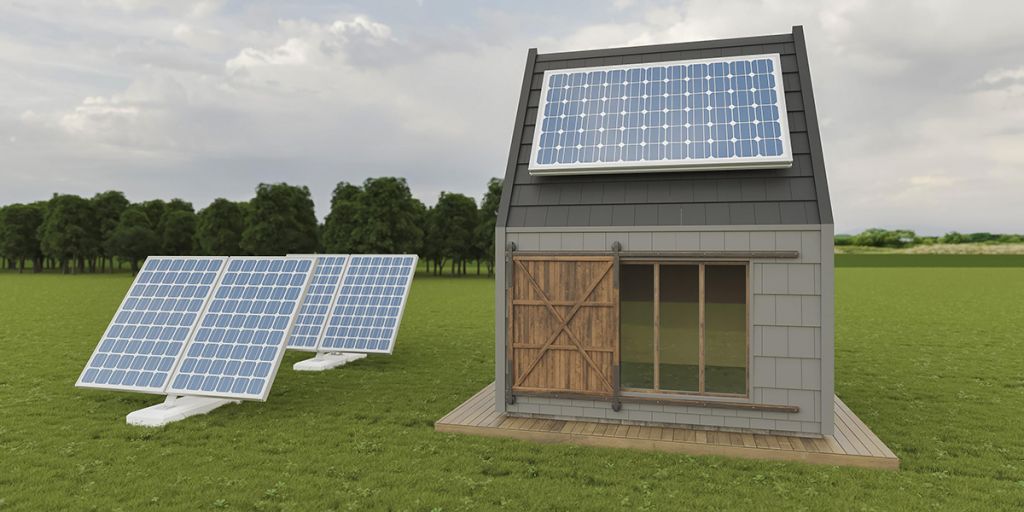Living in a tiny home doesn’t mean you have to skimp on modern conveniences, especially appliances, enough electricity, and a full-size fridge. While traditional homes guzzle energy, your compact tiny house abode offers the unique opportunity to harness solar energy efficiently and sustainably, reducing power consumption and providing enough electricity for all appliances. This shift towards solar electricity and solar power systems not only slashes your utility bills but also aligns with an eco-friendly lifestyle by utilizing home appliances powered by solar energy. Dive into the world of tiny home solar solutions where we’ll explore how small-scale panels can lead to big changes in how you live, power appliances, and impact the planet with watts of electricity and LED lights.
Overview of Solar Power Systems for Tiny Houses
Types Available
Tiny homes have unique needs for appliances and cell phone charging, and solar power systems with LED lights cater to these perfectly by providing electricity. There are mainly two types of solar energy systems: grid-tied and off-grid, for electricity and home appliances, with off-grid systems often including backup power.
Grid-tied systems connect to the local power grid. This allows homeowners to use electricity from the grid for their appliances when their solar energy system isn’t producing enough watts to meet the need. Off-grid systems, on the other hand, operate independently. They rely solely on solar energy collected by panels.
Both have their advantages. Grid-tied solar energy systems can save money on electricity for home appliances in areas with net metering policies. Off-grid electricity solutions offer freedom from utility companies but require careful energy management for home appliances.
Key Components
Every tiny home solar system comprises several crucial parts to generate electricity for appliances: panels, batteries, an inverter, and bluetooth communication for monitoring quantity.
-
Panels capture sunlight and convert it into electricity.
-
Batteries store this energy for later use.
-
The inverter changes direct current (DC) from solar panels and batteries into alternating current (AC), which powers most home appliances, efficiently managing the quantity of electricity.
Choosing high-quality components ensures your tiny house enjoys reliable solar power for years, supporting the quantity and efficiency of home appliances like a pro. It’s also essential to size each appliance correctly according to your energy needs and quantity.
To sum up, embracing a tiny home lifestyle doesn’t mean sacrificing comfort, modern conveniences, or the quantity of appliances. With the right solar power system, you can enjoy sustainable living without relying heavily on traditional energy sources. Whether you prefer a grid-tied or off-grid setup depends on your specific situation, but both options provide clean, renewable energy tailored for small spaces.
Benefits and Disadvantages of Solar Panels in Tiny Homes
Pros
Solar panels offer significant advantages for tiny home dwellers. The most notable benefit is the reduced environmental impact. By harnessing the power of the sun, tiny homes can operate more sustainably. This eco-friendly energy source aligns perfectly with the minimalist lifestyle many tiny home owners embrace.
Another major advantage is lower utility bills. After the initial setup, solar panels generate free electricity from sunlight. Over time, this can lead to substantial savings on energy costs.
-
Reduced environmental footprint
-
Lower ongoing utility expenses
However, it’s not all sunshine and rainbows.
Cons
The primary downside of installing solar panels on a tiny house is the initial setup cost. Solar systems can be expensive to purchase and install. For some, this upfront investment may be prohibitive.
Space requirements pose another challenge. Tiny homes have limited roof area for panel installation. This constraint might limit how much power you can generate.
Lastly, solar power depends heavily on weather conditions which could affect your power availability during cloudy or rainy days.
Sizing Your Solar Power System for Tiny Houses
Energy Needs
Before diving into solar solutions, it’s crucial to calculate your daily energy usage. This step determines the size of the system you need. Start by listing all electrical devices in your tiny house. Include everything from lights to the size fridge.
To get a clear picture, note how many hours each device runs per day. Then, multiply this by their wattage. The total gives you daily consumption in watts. Remember, accuracy here is key for an efficient solar power system.
Peak Sunlight Hours
Your location plays a big part in solar efficiency. It’s about peak sunlight hours – not just daylight hours but when the sun is strongest. This varies widely depending on where you live.
A place with more peak sunlight hours needs a smaller system compared to one with less sunlight. You can find average peak sunlight hours online or consult local experts for precise numbers.
Future Expansion
Thinking ahead is smart planning with tiny houses and solar solutions alike.
-
Consider potential energy needs if you plan expansions or add more appliances.
-
Upgrading later can be costly and complicated.
It’s better to slightly oversize your initial setup than to underprepare.
Solar Panel Costs, Financing Options, and ROI
Cost Range
The cost of solar panels for tiny homes varies. It depends on factors like roof space and power needs. Most systems range from $4,000 to $14,000.
Tiny houses have less roof space. This limits the number of panels you can install. But it also means lower costs since fewer panels are needed. Your budget plays a big role here. Always consider how much you’re willing to spend.
Financing Solutions
There are several ways to cover solar panel expenses.
-
Loans let you pay over time.
-
Leases offer low upfront costs but less savings long-term.
-
Incentives reduce costs through tax credits and rebates.
Loans are popular because they spread out payments. Leases require no initial investment but involve paying a company for energy produced by your roof’s panels. Incentives vary by location but can significantly cut down expenses.
ROI Timeframe
Solar panel investments pay off eventually through utility savings.
The timeframe depends on many factors:
-
Initial cost
-
Energy consumption
-
Local electricity rates
On average, homeowners see returns in 5 to 10 years. Tiny home owners might reach this sooner due to smaller systems and lower energy needs.
Choosing Between Grid vs. Off-Grid Solar Systems
Grid-Tied Benefits
Grid-tied solar systems offer backup power and the chance to earn from surplus energy. They connect to the local power grid, providing electricity when your panels don’t produce enough. This means you won’t be left without power on cloudy days.
Moreover, if your system generates more electricity than needed, you can sell this excess back to the grid. This not only reduces your electricity bills but might also provide additional income. Many find this aspect especially appealing after considering solar panel costs and ROI.
Off-Grid Independence
Off-grid systems mean complete freedom from utility companies. You rely solely on your solar setup for all energy needs, making it perfect for remote locations without reliable access to the power grid.
However, achieving true independence requires careful planning around energy consumption and battery storage capacity. Your system must generate enough electricity during sunny periods to cover both immediate use and charge batteries for later.
Hybrid Considerations
For those torn between benefits of both systems, hybrid solutions exist that combine features of grid-tied and off-grid setups.
-
Hybrid systems can connect to the grid for backup while primarily relying on stored solar energy.
-
They often include a larger battery capacity than typical off-grid setups, ensuring you have enough power even when disconnected from the main supply.
Choosing between these options depends on factors like location, energy usage, budget constraints following initial investment considerations discussed previously (“Solar Panel Costs”), and personal preference towards sustainability or financial incentives offered by renewable energy production.
Installation Considerations for Tiny House Solar Panels
Roof Space
Tiny homes have limited roof space. This affects where and how solar panels are installed. A south-facing orientation is best for efficiency. But, not all tiny homes can achieve this due to design or location.
The size of your roof determines the number of panels you can install. More panels mean more power but require more space. It’s a balancing act between power needs and available space.
Professional vs DIY
Installing solar panels might seem like a weekend project. But, it’s often more complex than it appears.
Professional installation ensures everything is done right from start to finish. They know how to maximize efficiency based on your home’s specifics.
DIY installations can save money upfront. However, they come with risks like incorrect installation or inefficiency.
Permits and Regulations
Solar installations are subject to local codes and regulations.
-
You need permits before starting work.
-
Compliance with electrical codes is crucial for safety.
Navigating these requirements can be daunting without professional help.
Customizing Solar Systems to Meet Your Needs
System Components
Customizing your solar system is crucial for efficiency. Every tiny home has a unique energy profile. This means tailoring solar panels, batteries, and inverters specifically. For example, if you use more power at night, you’ll need robust batteries.
The choice of components impacts how well the system meets your needs. Larger systems might be overkill for a tiny house. Meanwhile, too small could leave you short on power. It’s all about finding that sweet spot.
Smart Technology
Smart technology plays a big role in optimizing solar energy use. It can manage when and how electricity is used or stored. Imagine your appliances running when solar power is plentiful, thanks to smart systems.
This tech also helps in monitoring energy consumption and production real-time. You get to see which devices consume the most power and adjust accordingly.
Portable Solutions
For those with nomadic lifestyles, portable solar solutions are essential. They allow you to harness the sun’s power wherever you go.
-
Foldable panels
-
Portable batteries
-
Compact inverters
These items make it possible to live off-grid comfortably in different locations. Portable solutions mean freedom without sacrificing comfort or convenience.
Essential Pre-Installation Considerations for Tiny Home Owners
Site Assessment
Before installing solar solutions, conducting a site assessment is crucial. This step ensures your panels get maximum sunlight. Check the area around your tiny home. Look for tall trees or buildings that might block sunlight.
A professional can help you find the best spot. They use tools to predict sunlight patterns throughout the year. This helps in placing panels where they’ll catch the most rays.
Zoning Laws
Understanding local zoning laws and building codes is next. These regulations can greatly impact your solar installation plans. Some areas have strict rules about where and how you can install solar panels on tiny homes.
Research these laws early on to avoid surprises later. Contacting local authorities or a legal expert is a good idea. They can provide detailed information relevant to your area.
Insurance Adjustments
Finally, consider how adding solar panels might change your insurance needs. Solar installations increase your home’s value but also its replacement cost. Talk to your insurance provider about adjustments post-installation. This ensures you’re fully covered in case of damage or theft.
Embracing solar solutions for your tiny home isn’t just a step towards sustainable living; it’s a leap into a future where you’re in control of your energy needs. We’ve walked through the nuts and bolts—from sizing systems to weighing the pros and cons, and even tackling the financial side of things. It’s clear that going solar is more than feasible; it’s a smart move for both your wallet and the planet. Remember, every tiny home is unique, and so is every solar setup. Tailoring your system to meet your specific needs ensures you’re not just following a trend but are making an informed decision that benefits you long-term.
Now, it’s over to you. Dive into planning your solar solution with confidence. Reach out to professionals, crunch those numbers, and make your tiny home a beacon of efficiency and sustainability. Let’s light up the future, one solar panel at a time. Ready to take the plunge?


